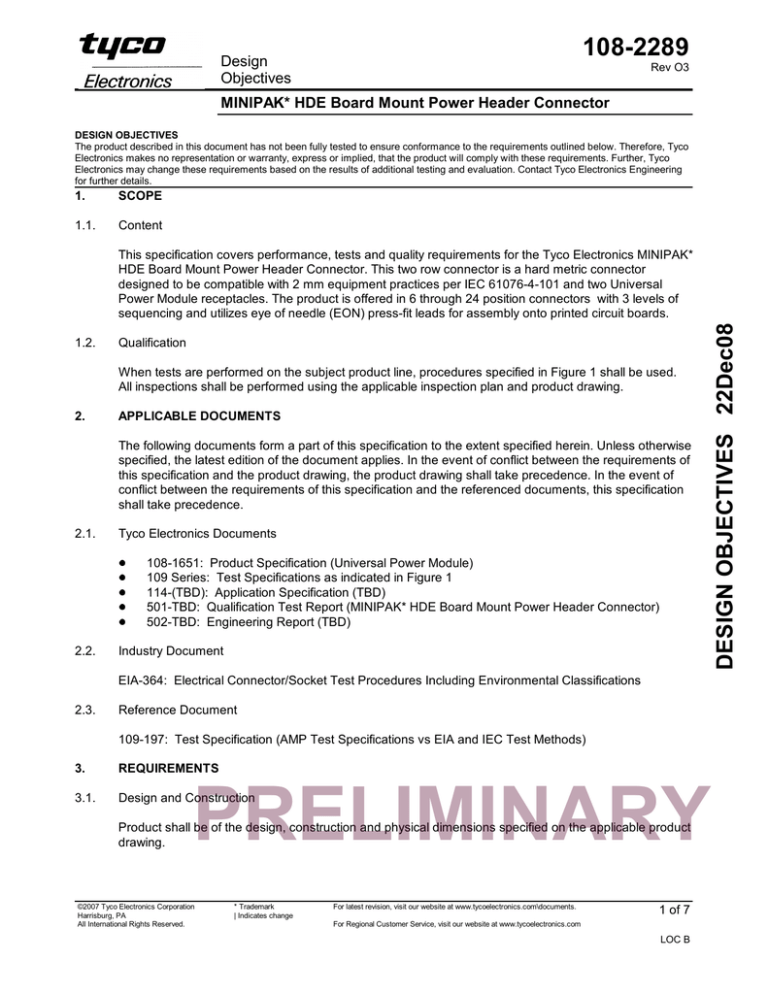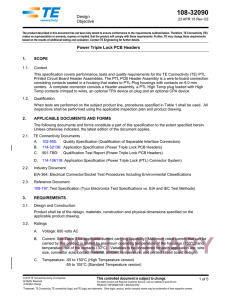
108-2289
Design
Objectives
Rev O3
MINIPAK* HDE Board Mount Power Header Connector
DESIGN OBJECTIVES
The product described in this document has not been fully tested to ensure conformance to the requirements outlined below. Therefore, Tyco
Electronics makes no representation or warranty, express or implied, that the product will comply with these requirements. Further, Tyco
Electronics may change these requirements based on the results of additional testing and evaluation. Contact Tyco Electronics Engineering
for further details.
1.
SCOPE
1.1.
Content
1.2.
Qualification
When tests are performed on the subject product line, procedures specified in Figure 1 shall be used.
All inspections shall be performed using the applicable inspection plan and product drawing.
2.
APPLICABLE DOCUMENTS
The following documents form a part of this specification to the extent specified herein. Unless otherwise
specified, the latest edition of the document applies. In the event of conflict between the requirements of
this specification and the product drawing, the product drawing shall take precedence. In the event of
conflict between the requirements of this specification and the referenced documents, this specification
shall take precedence.
2.1.
Tyco Electronics Documents
!
!
!
!
!
2.2.
108-1651: Product Specification (Universal Power Module)
109 Series: Test Specifications as indicated in Figure 1
114-(TBD): Application Specification (TBD)
501-TBD: Qualification Test Report (MINIPAK* HDE Board Mount Power Header Connector)
502-TBD: Engineering Report (TBD)
Industry Document
EIA-364: Electrical Connector/Socket Test Procedures Including Environmental Classifications
2.3.
Reference Document
109-197: Test Specification (AMP Test Specifications vs EIA and IEC Test Methods)
3.
REQUIREMENTS
3.1.
Design and Construction
PRELIMINARY
Product shall be of the design, construction and physical dimensions specified on the applicable product
drawing.
©2007 Tyco Electronics Corporation
Harrisburg, PA
All International Rights Reserved.
* Trademark
| Indicates change
For latest revision, visit our website at www.tycoelectronics.com\documents.
1 of 7
For Regional Customer Service, visit our website at www.tycoelectronics.com
LOC B
DESIGN OBJECTIVES 22Dec08
This specification covers performance, tests and quality requirements for the Tyco Electronics MINIPAK*
HDE Board Mount Power Header Connector. This two row connector is a hard metric connector
designed to be compatible with 2 mm equipment practices per IEC 61076-4-101 and two Universal
Power Module receptacles. The product is offered in 6 through 24 position connectors with 3 levels of
sequencing and utilizes eye of needle (EON) press-fit leads for assembly onto printed circuit boards.
108-2289
3.2.
Materials
Materials used in the construction of this product shall be as specified on the applicable product drawing.
Ratings
!
!
!
Voltage: 250 volts AC; 60 volts DC
Current:
•
18 amperes per contact (2x4 position connector, 30/C temperature rise at 23/C ambient, fully
energized, terminated to PCB). See Figure 1 for other positions and 502-TBD for further
current test details.
•
UL Current Interruption Rating: See 108-1651 for Universal Power Modules.
Temperature: -40 to 105/C
Number of Contacts Energized
Current (amperes)
1 (lower row)
2x3
2x4
2x6
2x8
26
23
18
17
16
2x10 2x12
15
14
Figure 1
Current per Contact at 30/C Temperature Rise
3.4.
Performance and Test Description
Product is designed to meet the electrical, mechanical and environmental performance requirements
specified in Figure 1. Unless otherwise specified, all tests shall be performed at ambient environmental
conditions.
3.5.
Test Requirements and Procedures Summary
Test Description
Requirement
Procedure
Initial examination of product.
Meets requirements of product
drawing.
EIA-364-18.
Visual and dimensional (C of C)
inspection per product drawing.
Document gold plating thickness at
contact interfaces.
Final examination of product.
Meets visual requirements.
EIA-364-18.
Visual inspection.
ELECTRICAL
Low Level Contact Resistance
(LLCR).
3 milliohms maximum.
3 milliohms maximum change.
EIA-364-23.
Subject specimens to 100
milliamperes maximum and 20
millivolts maximum open circuit
voltage.
See Figure 4.
Figure 1 (continued)
Rev O3
2 of 7
DESIGN OBJECTIVES 22Dec08
3.3.
108-2289
Requirement
Procedure
Contact resistance at rated current. 2 milliohms maximum, end of life.
EIA-364-6.
Measure millivolt drop at specified
currents.
For 1 lower row contact energized,
26 amperes and TBD amperes at
30/C temperature rise end of life.
For 2 x 6 contacts energized, 17
amperes and TBD amperes at 30/C
temperature rise end of life.
For 2 x 12 contacts energized, 14
amperes and TBD amperes at 30/C
temperature rise end of life.
Insulation resistance.
10000 megaohms minimum.
EIA-364-21.
500 volts DC, 2 minute hold.
Test between adjacent contacts of
mated specimens.
Withstanding voltage.
One minute hold with no breakdown EIA-364-20, Condition I.
or flashover.
2120 volts DC at sea level.
Test between adjacent contacts of
mated specimens.
Temperature rise vs current.
30/C maximum temperature rise.
See Figure 1 for maximum current
at 30/C temperature rise.
EIA-364-70, Method 1.
Stabilize at a single current level
until 3 readings at 5 minute intervals
are within 1/C. Test with single
lower row energized contact and
with 2x3, 2x4, 2x6, 2x8, 2x10 and
2x12 power contacts energized.
Record data over a range of 20 to
50/C temperature rise. Document
30/C temperature rise current.
MECHANICAL
Random vibration.
No discontinuities of 1 microsecond EIA-364-28, Test Condition VII,
or longer duration.
Condition E.
See Note.
Subject mated specimens to 4.90
G's rms between 20 to 500 Hz.
Fifteen minutes in each of 3
mutually perpendicular planes.
See Figure 5.
Mechanical shock.
No discontinuities of 1 microsecond EIA-364-27, Condition A.
or longer duration.
Subject mated specimens to 50 G's
See Note.
half-sine shock pulses of 11
milliseconds duration. Three shocks
in each direction applied along 3
mutually perpendicular planes, 18
total shocks.
See Figure 5.
Figure 2 (continued)
Rev O3
3 of 7
DESIGN OBJECTIVES 22Dec08
Test Description
108-2289
Requirement
Procedure
Durability.
See Note.
EIA-364-9.
Mate and unmate specimens for
250 cycles at a maximum rate of
325 cycles per hour.
Mating force.
1.0 N maximum per contact.
EIA-364-13.
Measure force necessary to mate
specimens at a maximum rate of
25.4 mm per minute.
Unmating force.
0.5 N minimum per contact.
EIA-364-13.
Measure force necessary to
unmate specimens at a maximum
rate of 25.4 mm per minute.
Compliant pin insertion.
44.5 N maximum average per pin.
TE Spec 109-41.
Measure force necessary to seat
pins into a printed circuit board at a
maximum rate of 25.4 mm per
minute.
Compliant pin retention.
4.4 N minimum average per pin.
TE Spec 109-30.
Measure force necessary to unseat
pins from a printed circuit board at a
maximum rate of 25.4 mm per
minute.
Contact retention.
Axial displacement shall not exceed TE 109-30.
0.2 mm with force applied or 0.1
Apply axial force of 10 N to pin
mm after force has been removed. contacts in the unmating direction
at a maximum rate of 2.54 mm per
minute and hold for 5 seconds.
Apply axial force of 5 N to pin
contacts in the mating direction at a
maximum rate of 2.54 mm per
minute and hold for 5 seconds.
ENVIRONMENTAL
Thermal shock.
See Note.
EIA-364-32.
Subject mated specimens to 5
cycles between -40 and 105/C with
30 minute dwells at temperature
extremes.
Humidity/temperature cycling.
See Note.
EIA-364-31, Method III.
Subject specimens to 10 cycles (10
days) between 25 and 65/C at 80 to
100% RH.
Temperature life.
See Note.
EIA-364-17, Method A, Test
Condition 3, Test Time Condition C.
Subject mated specimens to 85/C
for 500 hours.
Figure 2 (continued)
Rev O3
4 of 7
DESIGN OBJECTIVES 22Dec08
Test Description
108-2289
Test Description
Requirement
Mixed flowing gas.
Procedure
See Note.
EIA-364-65, Class IIA (4 gas).
Subject specimens to
environmental Class IIA for 20 days
(10 days unmated, 10 days mated).
Shall meet visual requirements, show no physical damage, and meet requirements of additional
tests as specified in the Product Qualification and Requalification Test Sequence shown in Figure
3.
NOTE
Figure 2 (end)
3.6.
Product Qualification and Requalification Test Sequence
Test Group (a)
1
2
3
4
5
DESIGN OBJECTIVES 22Dec08
Test or Examination
Test Sequence (b)
Initial examination of product
1
LLCR
1
1
1
3,7
1
2,5,7,9
Contact resistance at rated current
11
Insulation resistance
2,6
Withstanding voltage
3.7
Temperature rise vs current
3(c),10
Random vibration
5
Mechanical shock
6
Durability
4
Mating force
2
Unmating force
8
Compliant pin insertion
2
Compliant pin retention
3
8
Contact retention
2
Thermal shock
4
Humidity/temperature cycling
5
Temperature life
6
Mixed flowing gas
Final examination of product
NOTE
(a)
(b)
(c)
(d)
4(d)
4
9
8
3
12
See paragraph 4.1.A.
Numbers indicate sequence in which tests are performed.
Precondition specimens with 10 durability cycles.
Measure LLCR after 10 days unmated.
Figure 3
Rev O3
5 of 7
108-2289
4.
QUALITY ASSURANCE PROVISIONS
4.1.
Qualification Testing
A.
Specimen Selection
Specimens shall be prepared in accordance with applicable Instruction Sheets and shall be
selected at random from current production. Test groups 1, 2, 3, and 4 shall consist of 5 mated
pairs of UPM receptacles and right angle MINIPAK HDL plugs. Test group 5 shall consist of 3
mated pairs of UPM receptacles and right angle MINIPAK HDL plugs.
B.
Test Sequence
Qualification inspection shall be verified by testing specimens as specified in Figure 3.
Requalification Testing
If changes significantly affecting form, fit or function are made to the product or manufacturing process,
product assurance shall coordinate requalification testing, consisting of all or part of the original testing
sequence as determined by development/product, quality and reliability engineering.
4.3.
Acceptance
Acceptance is based on verification that the product meets the requirements of Figure 1. Failures
attributed to equipment, test setup or operator deficiencies shall not disqualify the product. If product
failure occurs, corrective action shall be taken and specimens resubmitted for qualification. Testing to
confirm corrective action is required before resubmittal.
4.4.
Quality Conformance Inspection
The applicable quality inspection plan shall specify the sampling acceptable quality level to be used.
Dimensional and functional requirements shall be in accordance with the applicable product drawing and
this specification.
Rev O3
6 of 7
DESIGN OBJECTIVES 22Dec08
4.2.
108-2289
DESIGN OBJECTIVES 22Dec08
TBD
Figure 4
Low Level Contact Resistance Measurement Points
TBD
Figure 5
Vibration & Mechanical Shock Mounting Fixture
Rev O3
7 of 7






